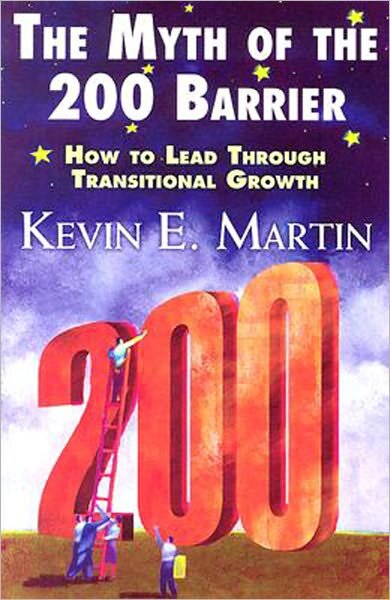Kevin E. Martin, The Myth of the 200 Barrier: How to Lead Through Transitional Growth. Abingdon Press, 2005.
Referenced in: Church Leadership – Size Dynamics and Transitions
LifeandLeadership Summary
This is perhaps the best book available on size transitions for smaller congregations. Lyle Schaller, a prolific author in church leadership, and the one whom the author, Kevin Martin calls his mentor, says “This is the best book I have ever read on congregational development! I wish I had written it.” This is a significant accolade coming from the dean of church strategists.
This book addresses the transitional dynamics of congregations with average Sunday attendance (ASA) somewhere between 150-225. Like most authors on this subject, Martin adopts the Rothauge model to compare the characteristics of smaller (pastoral size, up to 150) and larger (program size, 151-350) churches, pointing out that churches with ASA between 150-225 have residual characteristics of the smaller with developing features of the larger, and are thus transitional between two distinct cultures. Congregations have certain cultures, or “ways we do things around here,” and the “rule of 150,” or tribal size culture, works in ways that work against the emergence into program size. Thus, “to grow a small church into a large one is to transform the very culture of the congregation.” If a church starts exceeding an ASA of 150, it will become increasingly anxious and unstable unless it experiences that cultural shift. Some in the church wish to retain the loving and intimate small tribal/family culture, while others, perhaps even one’s denomination, exert pressure for the church to initiate the programming and needs-based services of a larger church.
The key to navigating this transition is the “transformational” leader who helps a church shape into a completely different culture, over against other leaders who tend toward small incremental/congruent changes that leave the tribal system intact. Through the sympathetic profiles of Pastor John, Pastor Ted, and Pastor Sally, as well as several case studies of congregational issues, he illustrates the unique characteristics and stresses of transformational leaders. He realistically describes the tensions felt by both leader and congregation, and how different leader types engage the realities of the transitional church culture. He explains why most transformational change efforts fail, and the most likely scenarios for actually reaching the tipping point and successfully changing into a program size congregation. Of special value is chapter 14, “What the Large Church Knows,” a picture of what a truly transformed culture looks like – needs-based ministries, organized paid and volunteer staff, pastoral care that is less dependent on the paid staff, a “multiple matrix” system consisting of several small “congregations” within the larger group, redefined roles for the church board (e.g. elders), and a commitment to excellence.
Throughout this book, Martin weaves the best of organizational leadership, systems, church health, conflict resolution, and change/transition management into a highly readable and experience-grounded guide to transitional ministry.
Martin addresses the same issue taken up by Bill Sullivan’s New Perspectives on Breaking the 200 Barrier and Alice Mann’s Raising the Roof. Of the three, Martin is my top suggestion because of his more extensive discussion of the best practices of transformational leaders, especially as they must deal with resistance. Understanding the overall dynamics (Mann) and designating the specific choice points (Sullivan) are important, but navigating the unique struggles of leading churches through these (Martin) is the key.
From the Publisher
The common experience of large congregations getting larger and small congregations getting smaller has given rise to the belied that growing congregations tend to hit a barrier at the 150-200 attendance mark. The dividing line in American church attendance is 150 people on an average Sunday. Churches below this seem to have a harder time growing. Above this, churches seem to have an easier time growing. Trying to grow a smaller church can feel like trying to break through what Martin calls the “200 Barrier,” Martin explains that there is no barrier; there are just two different ways of being a church the pastoral size congregation and the program size congregation.
Contrary to the conventional wisdom, 200 members is not a magic number, beyond which lies guaranteed congregational growth and effectiveness. The truth, says Kevin Martin, is that churches with under 150 are often organized around the personality of the pastor, while churches of over 200 members organize around their programs. In between lies the transitional, a hybrid of these two cultures, and this dual nature produces stress and tension where the idea of a 200 Barrier often becomes a self-fulfilling expectation. Martin helps pastors and other congregational leaders understand this tricky transition, plan for the move to a larger church culture that becomes self-supporting, and avoid mistakes in their effort to grow “beyond the barrier.”
About the Author
Kevin E. Martin is a well-known preacher, teacher, author and consultant in the Episcopal Church. He is the founder and executive director of Vital Church Ministries, a teaching and consulting outreach of the Cathedral Church of Saint Matthew in Dallas, Texas. He has served as Canon for Congregational Development in the Diocese of Texas. Prior to that, he was the rector for three congregations, was a hospital chaplain, and led the Leadership Training Institute in Evergreen, Colorado where he worked extensively in planning and executing national and regional conferences.
***For additional information on this resource, including reviews, click the bookstore links. Check the reference at page top or the links below for resource guides on related topics.***
See Resources on Over 100 Areas of Ministry Leadership:


